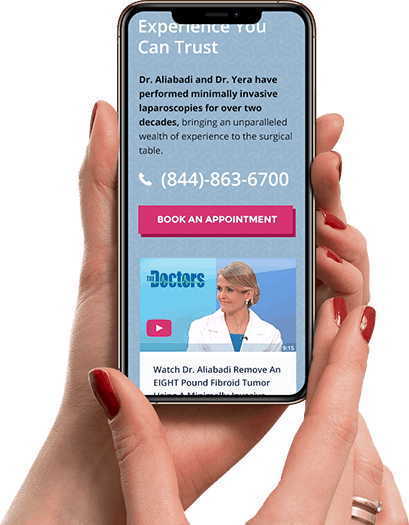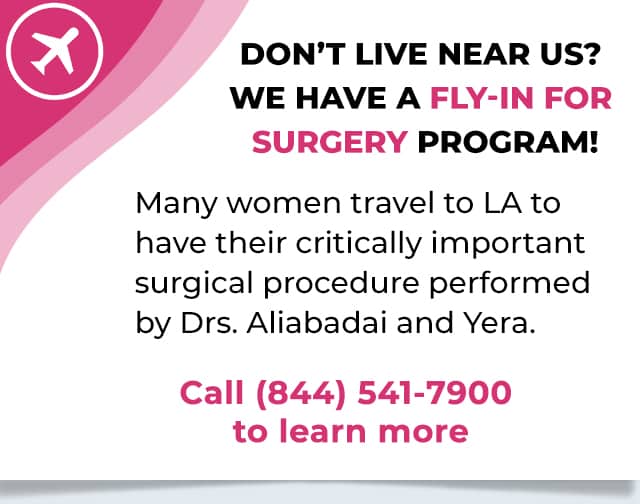Abdominal pain can be scary, not only because of the discomfort, but also the wide number of potential causes. Some of the culprits of pain in the lower abdomen can be hard to distinguish from one another. For example, an ovarian cyst rupture can cause symptoms similar to acute appendicitis. These organs are near one another, and radiating pain isn’t always easy to pinpoint. Fortunately, ovarian cyst ruptures are only life-threatening in very rare occasions.
However, acute appendicitis requires immediate treatment, making it essential to be able to distinguish between the two.

What can cause abdominal pain?
There are many potential causes for pain in your abdomen, and some are more urgent than others.
Causes of pelvic pain include:
- Ovarian cysts
- Appendicitis
- Uterine fibroids
- Peritonitis (inflamed abdominal lining)
- Urinary tract infection (UTI)
- Ectopic pregnancy
- Endometriosis
Fortunately, the general location of the pain can help you tell the difference between the different causes.
Diagnosing pelvic pain based on side
Pain in the lower-right abdomen is often the most concerning. Pain in the right side of your stomach could mean that you have a right ovarian cyst rupture or are experiencing appendicitis. Both of these organs are located in the right lower quadrant of your torso. lower right pain may also be attributed to indigestion or kidney problems.
Alternatively, pain in the lower left abdominal quadrant is usually associated with hernias or diverticulitis.
Because there are so many potential causes, which side the pain occurs on is not enough to determine the source.
Right-sided ovarian cyst pain
Your ovaries flank your uterus, one on either side. Sitting below the fallopian tubes, your ovaries can range from two centimeters to six centimeters in size, with the average ovary measuring about four centimeters.
An ovarian cyst is when a sac develops on or in the ovary and fills with fluid. It’s not uncommon for a cyst to develop with the menstrual cycle and go away with little to no discomfort or treatment. However, sometimes complications can arise from the cyst.
One potential complication of ovarian cysts is ovarian torsion — the weight of the cyst(s) causes the structures supporting the ovary to twist. Not only is torsion painful, it can cut off blood flow and cause damage to the ovary. Additionally, an ovarian cyst may burst (or rupture).
Both rupture and torsion can cause pronounced pain and other symptoms such as nausea, vomiting, and vaginal bleeding. For mild to moderate cyst ruptures, the pain will often go away in a few days, unlike appendix rupture pain which does not improve.
It’s important to note that certain health conditions can also increase your risk of ovarian cysts. Such as:
- Pelvic inflammatory disease (PID) can cause a tubo-ovarian abscess in which an infection in the ovary and fallopian tube causes a pocket of pus to form.
- Polycystic ovarian syndrome (PCOS) can lead to many small cysts on the ovaries.
Both conditions may lead to more pronounced lower abdominal pain than the more common, minor, menstrual-related cysts.
Right-sided appendix pain
Your appendix looks like a small pouch measuring approximately three to four inches. It hangs off your colon (large intestine) and sits between the large and small intestine on your right side.
Appendicitis is when the appendix becomes inflamed and filled with fluid or pus. Usually, it is either due to a blockage of stool in the intestinal tract or infection from a bacteria, virus, or parasite. As the inflamed appendix grows and the infection worsens, pain and other symptoms may ensue, resulting in a possibly life-threatening rupture if not treated.
Appendicitis symptoms, including pain, tend to come on more suddenly. Pain often starts near your belly button and then migrates toward your lower right quadrant. In most cases, treatment for appendicitis is surgical removal of the organ. If the appendix bursts before it can be removed, the lining of your abdomen and surrounding organs are susceptible to becoming infected, causing damage and in some cases, death.
What symptoms can be caused by both appendicitis and an ovarian cyst?
Not only are your right ovary and appendix near one another, but they are also frequently responsible for abdominal pain. According to the U.S. Department of Health and Human Services, “most women make at least one follicle or corpus luteum cyst every month.” Similarly, appendicitis is the most common cause of severe abdominal pain unrelated to gynecological issues. Aside from prevalence and location, these two conditions can share a few other commonalities.
Abdominal pain on your lower right side is the primary symptom. But you may also experience:
- Fever
- Nausea
- Vomiting
- Bloating in your abdomen

Call 877-760-3564 or click here to schedule online
How do ovarian cyst and appendicitis symptoms differ?
Fortunately, there are differences in symptoms. Because ovarian cysts aren’t uncommon during the menstrual cycle of female patients of reproductive age, often forming around the time of ovulation, the discomfort from cysts may fluctuate or come and go entirely, sometimes appearing as a cramping feeling. When a cyst ruptures, the pain will usually be more severe and sudden, radiating from the lower right quadrant of your abdomen to your lower back. Additionally, you may have vaginal bleeding or spotting, dizziness, and feel faint. Finally, ovarian cyst pain can be felt on either or both sides, depending on which ovary has the cyst.
Appendicitis is typically associated with acute abdominal pain that starts suddenly. Additionally, appendicitis pain often begins near the belly button, gradually moving toward the lower right abdomen area. Pressure on the spot can cause the pain to become more intense, as can coughing, sneezing, or deep breathing. Other symptoms of appendicitis include loss of appetite, gastrointestinal upset, and bowel issues such as diarrhea or constipation.
Can you have both appendicitis and an ovarian cyst?
Unfortunately, yes! Because your appendix and ovaries are separate organs, you can, sadly, have a problem with both of them at the same time.
When should you be concerned about lower abdominal pain?
Even though ovarian cysts often aren’t a cause for concern, a ruptured cyst can pose problems if left undiagnosed and untreated. Furthermore, appendicitis should always be treated by a medical professional, as a burst appendix can quickly become life-threatening. If you are having severe abdominal pain in your lower right quadrant, it’s a good idea to seek medical help. A physical exam can determine the cause of your pain and ensure you’re receiving proper treatment.
Other signs that you should get immediate medical assistance include:
- Vomiting
- Fever
- Heavy bleeding
- Rapid breathing
- Dizziness or fainting
- Weakness
How can doctors give a differential diagnosis?
In order to tell the conditions apart, most emergency department doctors will begin with a physical examination and discuss your medical history and symptoms. Blood and urine tests can help rule out things like UTIs and signal whether or not an infection could be the issue. They may also request imaging tests such as a computerized tomography scan (CT scan), X-ray, ultrasound, or magnetic resonance imaging (MRI) to better look at the organs inside your abdomen.
Medical care is necessary because an untreated appendix can lead to serious complications like sepsis.
Do all ovarian cysts need treatment?
Unlike a ruptured appendix, which is typically treated through an appendectomy (removal of the appendix), not all ovarian cysts require treatment. Ovarian cysts rarely cause life-threatening problems, though in some cases they may pose a risk of sepsis. Some don’t rupture and clear up on their own, meaning you may not even realize you have one. If your cyst ruptures, your doctor may treat you in the hospital with intravenous fluids and pain medication. Hemorrhagic ovarian cysts, or those that cause internal bleeding, might require surgery.
In some cases, this can be done laparoscopically through a minimally invasive procedure known as a laparoscopic ovarian cystectomy. In most cases, only the cyst will need to be removed, though sometimes the entire ovary must be taken out. Obviously, removal of an ovary can impact fertility, but most ovarian cysts do not negatively affect your ability to get pregnant on their own.
Nevertheless, if you have persistent ovarian cysts, contacting our OB/GYN is a good idea. They can look for any gynecological concerns, like polycystic ovary syndrome (PCOS) or more significant ovarian cysts and guide you through management and treatment.
Worried about pelvic pain? Talk to the Outpatient Hysterectomy Center!
Drs. Aliabadi and Yera are renowned masters of gynecology, obstetrics, and gynecological surgery. Patients travel from around the country to be treated at the Outpatient Hysterectomy Center and Dr. Aliabadi even travels to teach her surgical expertise to other doctors.
OHC is committed to providing the best women’s health care; our staff chooses the least invasive treatment option whenever possible.
We invite you to establish care with the Outpatient Hysterectomy Center. Please make your appointment online or call us at (844) 863-6700.
The Outpatient Hysterectomy Center is conveniently located for patients residing throughout Southern California and the Los Angeles area. At the Cedars-Sinai Medical Center, we are near Beverly Hills, West Hollywood, Santa Monica, West Los Angeles, Culver City, Hollywood, Venice, Marina del Rey, Malibu, Manhattan Beach, and Downtown Los Angeles, to name a few.











